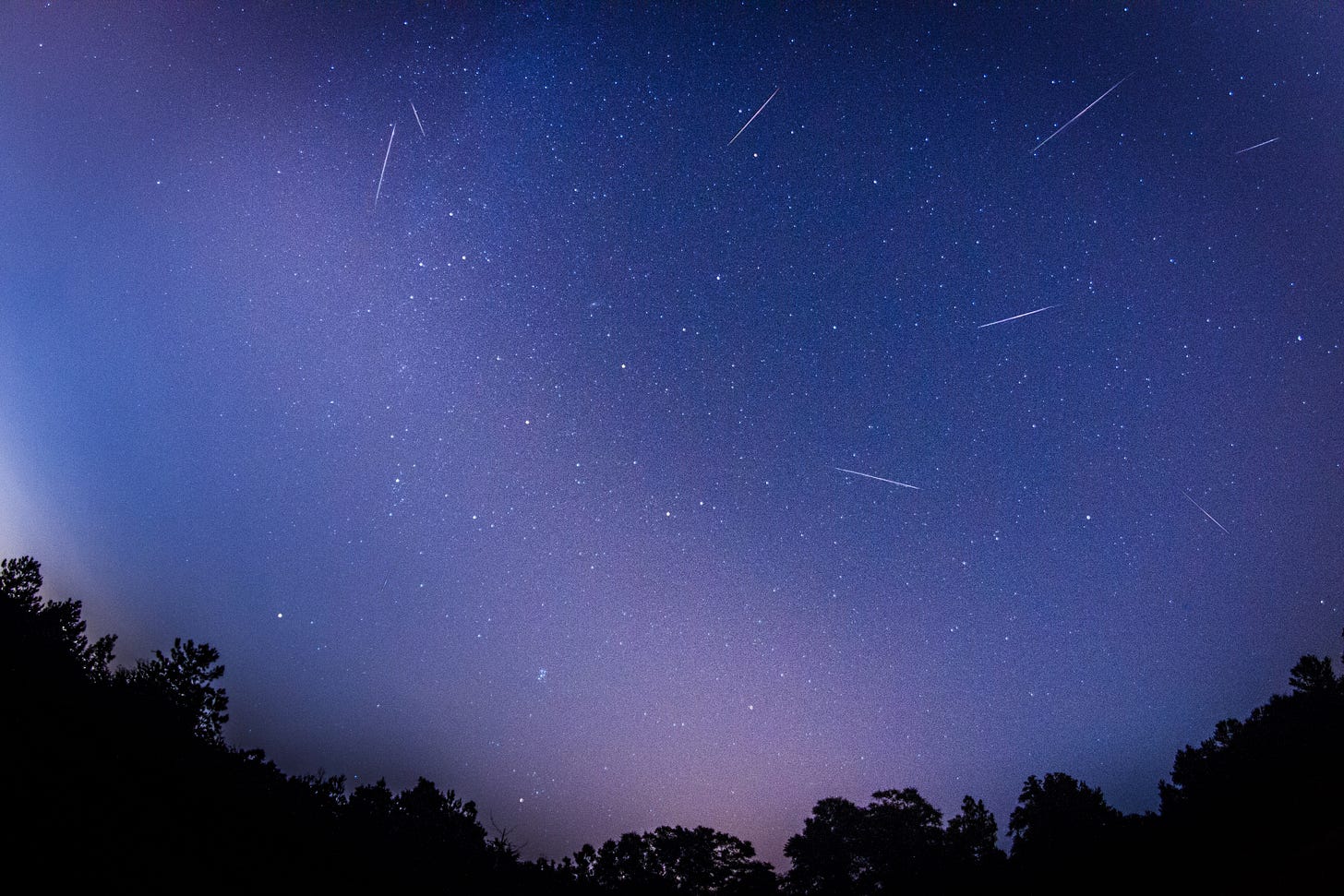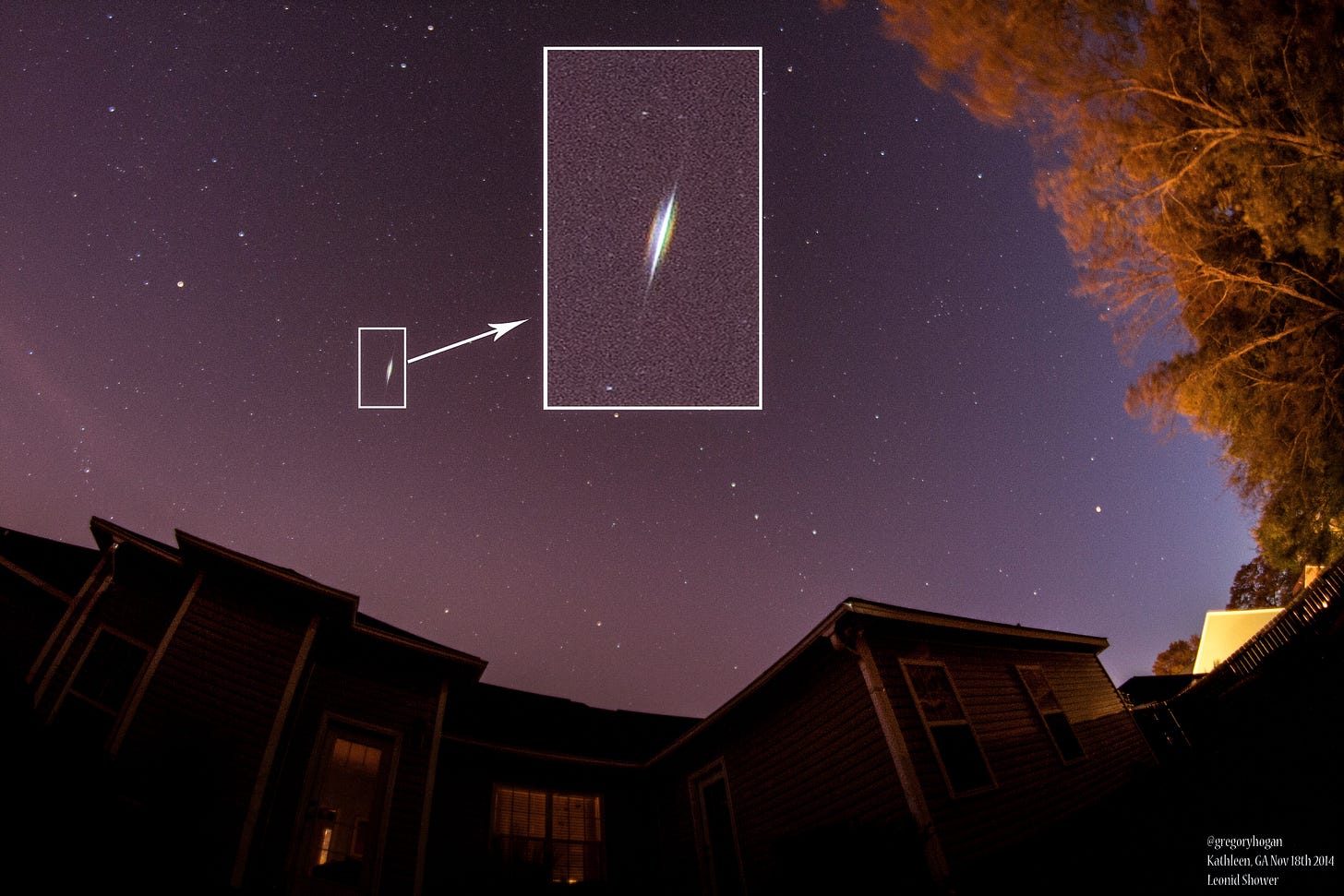Chasing Fleeting Wonders
Arietids Meteor Shower
Chasing Fleeting Wonders: Arietids Meteor Shower
As I prepared to wake up before dawn this past weekend and into today, I’m filled with anticipation for the Arietids meteor shower (June 7th through 10th, 2025), one of nature’s most elusive spectacles. Known as the most active daytime meteor shower, the Arietids offer a unique challenge and a magical reward for those willing to rise early and gaze at the eastern horizon. These meteors, streaking from the constellation Aries, are often called “Earthgrazers” because they skim low, bright, and slow across the sky, creating breathtaking trails in the pre-dawn twilight.
The Arietids are active from May 29 to June 17, with their peak arriving around June 7th to 10th. The best viewing occurs on the mornings of the first 10 days of June, just before dawn. Unlike most meteor showers that dazzle under a midnight sky, the Arietids are unique because their radiant, the point from which the meteors appear to originate, is only 30 degrees from the Sun, making them primarily a daytime event. However, in that narrow window before sunrise, when the sky is still dark enough to see stars, you can catch these meteors shooting upward from the horizon in Aries, the Ram, located in the east.
To see them, find a dark location away from city lights, face east, and start watching about an hour before sunrise; around 3:00 AM local time, depending on your location. Allow your eyes 20 minutes to adjust to the darkness, and look for bright, slow-moving streaks that may stretch far across the sky. The Arietids boast an impressive zenithal hourly rate (ZHR) of 60 to 200 meteors per hour, according to radar data, though you might only spot a few in the pre-dawn hour due to the encroaching daylight. Their speed, about 39 km/s (87,000 mph), and their possible origins, potentially from asteroid 1566 Icarus or comet 96P/Machholz, add to their mystique. No special equipment is needed; just patience, a clear view of the eastern horizon, and perhaps a blanket to keep warm.
Watching the Arietids, I’m reminded of how fleeting beauty can be here, one moment, gone the next, like a meteor’s bright arc across the sky. These shooting stars are a perfect metaphor for life’s brightest moments: a child’s laughter, a shared glance with a loved one, or an unexpected act of kindness. These moments don’t last, but their brevity doesn’t diminish their value. Instead, it invites us to embrace them fully, to be present, and to cherish their light.
Scripture echoes this truth. In James 4:14, we read, “What is your life? You are a mist that appears for a little while and then vanishes.” This verse isn’t meant to make us mourn life’s transience but to inspire us to live intentionally, savoring each moment as a gift. The Arietids, with their brief, brilliant trails, remind me to see life’s fleeting joys not as losses but as treasures to be celebrated. Just as I’ll rise early to catch a glimpse of these meteors, I want to be awake to life’s bright moments; those sparks of joy, love, and connection that light up our days.
The Arietids teach us to embrace the ephemeral. It’s tempting to view fleeting moments, like a meteor’s flash or a perfect day, as bittersweet because they end. But what if we saw them as invitations to gratitude? Psalm 118:24 says, “This is the day that the Lord has made; let us rejoice and be glad in it.” Each meteor I hope to see this weekend is a reminder to rejoice in the now, to let go of regret over what fades, and to trust that God’s goodness fills even the briefest moments.
Last week, thanks to the generosity of subscribers to Our Night Sky, I was able to buy a meal for someone in need; a small but shining moment of kindness made possible by our community. It was a meteor-like moment: quick, meaningful, and beautiful. These acts, like the Arietids, don’t last forever, but their impact lingers in the heart. The contributions from our supporters allow us to keep giving back, turning fleeting moments of generosity into lasting ripples of hope.
How to Enjoy the Arietids
Here’s how you can join me in chasing the Arietids this weekend:
When: June 7–10, 2025, with the peak on the morning of June 7. Watch from 3:00 AM until just before dawn (check your local sunrise time).
Where: Face east, toward the constellation Aries. Find a dark site with a clear view of the horizon, away from city lights.
What to Bring: A blanket or chair, warm clothes, and patience. No telescope or binoculars needed—just your eyes.
Pro Tip: Look for “Earthgrazers,” slow and bright meteors that skim the horizon.
As I prepare to watch the Arietids, I’m not just chasing meteors; I’m chasing a mindset. Ecclesiastes 3:1 reminds us, “There is a time for everything, and a season for every activity under the heavens.” The season of the Arietids is short, just like so many of life’s brightest moments. But their beauty lies in their impermanence, urging us to show up, pay attention, and give thanks. Whether it’s a meteor streaking across the sky, a kind word shared, or a quiet moment of awe, these are the sparks that make life radiant.
So, set your alarm, grab a coffee, and join me in watching for the Arietids this weekend. Let’s celebrate the fleeting, beautiful moments, both in the sky and in our lives, and hold them as gifts to be remembered, not regretted. And if you’re moved to support Our Night Sky, know that your contribution helps us light up lives, one small act of kindness at a time.
Keep looking up!
-g
Interested in helping support this ministry? Can I suggest a donation to buy a coffee so I can take someone out who may need someone to chat with? I have found this to be an amazing way to engage someone who needs that extra push to open up and engage in a conversation of support and love.
coff.ee/ournightsky






